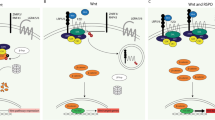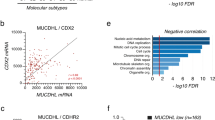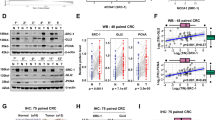Abstract
SPROUTY-2 (SPRY2) regulates receptor tyrosine kinase signalling and therefore cell growth and differentiation. In this study, we show that SPRY2 expression in colon cancer cells is inhibited by the active vitamin D metabolite 1α,25-dihydroxyvitamin D3 (1,25(OH)2D3) through E-cadherin-dependent and -independent mechanisms. In turn, SPRY2 represses both basal and 1,25(OH)2D3-induced E-cadherin expression. In line with this, SPRY2 induces ZEB1 RNA and protein, but not that of other epithelial-to-mesenchymal transition inducers that repress the CDH1/E-cadherin promoter. Consistently, SPRY2 and E-cadherin protein levels inversely correlate in colon cancer cell lines and xenografted tumours. Moreover, SPRY2 knockdown by small hairpin RNA increases CDH1/E-cadherin expression and, reciprocally, CDH1/E-cadherin knockdown increases that of SPRY2. In colon cancer patients, SPRY2 is upregulated in undifferentiated high-grade tumours and at the invasive front of low-grade carcinomas. Quantification of protein expression in 34 tumours confirmed an inverse correlation between SPRY2 and E-cadherin. Our data demonstrate a tumourigenic action of SPRY2 that is based on the repression of E-cadherin, probably by the induction of ZEB1, and a reciprocal regulation of SPRY2 and E-cadherin that dictates cell phenotype. We propose SPRY2 as a candidate novel marker for high-grade tumours and a target of therapeutic intervention in colon cancer.
This is a preview of subscription content, access via your institution
Access options
Subscribe to this journal
Receive 50 print issues and online access
$259.00 per year
only $5.18 per issue
Buy this article
- Purchase on Springer Link
- Instant access to full article PDF
Prices may be subject to local taxes which are calculated during checkout










Similar content being viewed by others
Abbreviations
- 1,25(OH)2D3:
-
1α, 25-dihydroxyvitamin D3
- SPRY2:
-
SPROUTY-2
References
Aguilera O, Pena C, Garcia JM, Larriba MJ, Ordonez-Moran P, Navarro D et al. (2007). The Wnt antagonist DICKKOPF-1 gene is induced by 1alpha,25-dihydroxyvitamin D3 associated to the differentiation of human colon cancer cells. Carcinogenesis 28: 1877–1884.
Batlle E, Sancho E, Francí C, Domínguez D, Monfar M, Baulida J et al. (2000). The transcription factor Snail is a repressor of E-cadherin gene expression in epithelial tumour cells. Nat Cell Biol 2: 84–89.
Bloethner S, Chen B, Hemminki K, Muller-Berghaus J, Ugurel S, Schadendorf D et al. (2005). Effect of common B-RAF and N-RAS mutations on global gene expression in melanoma cell lines. Carcinogenesis 26: 1224–1232.
Bremm A, Walch A, Fuchs M, Mages J, Duyster J, Keller G et al. (2008). Enhanced activation of epidermal growth factor receptor caused by tumor-derived E-cadherin mutations. Cancer Res 68: 707–714.
Buck E, Eyzaguirre A, Barr S, Thompson S, Sennello R, Young D et al. (2007). Loss of homotypic cell adhesion by epithelial-mesenchymal transition or mutation limits sensitivity to epidermal growth factor receptor inhibition. Mol Cancer Ther 6: 532–541.
Cabrita MA, Christofori G . (2008). Sprouty proteins, masterminds of receptor tyrosine kinase signaling. Angiogenesis 11: 53–62.
Campbell MJ, Adorini L . (2006). The vitamin D receptor as a therapeutic target. Expert Opin Ther Targets 10: 735–748.
Cano A, Pérez-Moreno MA, Rodrigo I, Locascio A, Blanco MJ, del Barrio MG et al. (2000). The transcription factor Snail controls epithelial-mesenchymal transitions by repressing E-cadherin expression. Nat Cell Biol 2: 76–83.
Christofori G, Semb H . (1999). The role of the cell-adhesion molecule E-cadherin as a tumour-suppressor gene. Trends Biochem Sci 24: 73–76.
Deeb KK, Trump DL, Johnson CS . (2007). Vitamin D signalling pathways in cancer: potential for anticancer therapeutics. Nat Rev Cancer 7: 684–700.
Ding W, Shi W, Bellusci S, Groffen J, Heisterkamp N, Minoo P et al. (2007). Sprouty2 downregulation plays a pivotal role in mediating crosstalk between TGF-beta1 signaling and EGF as well as FGF receptor tyrosine kinase-ERK pathways in mesenchymal cells. J Cell Physiol 212: 796–806.
Eelen G, Gysemans C, Verlinden L, Vanoirbeek E, De Clercq P, Van Haver D et al. (2007). Mechanism and potential of the growth-inhibitory actions of vitamin D and ana-logs. Curr Med Chem 14: 1893–1910.
Efstathiou JA, Liu D, Wheeler JM, Kim HC, Beck NE, Ilyas M et al. (1999). Mutated epithelial cadherin is associated with increased tumorigenicity and loss of adhesion and of responsiveness to the motogenic trefoil factor 2 in colon carcinoma cells. Proc Natl Acad Sci USA 96: 2316–2321.
Egan JE, Hall AB, Yatsula BA, Bar-Sagi D . (2002). The bimodal regulation of epidermal growth factor signaling by human Sprouty proteins. Proc Natl Acad Sci USA 99: 6041–6046.
Fong CW, Chua MS, McKie AB, Ling SH, Mason V, Li R et al. (2006). Sprouty 2, an inhibitor of mitogen-activated protein kinase signaling, is down-regulated in hepatocellular carcinoma. Cancer Res 66: 2048–2058.
Frank MJ, Dawson DW, Bensinger SJ, Hong JS, Knosp WM, Xu L et al. (2009). Expression of sprouty2 inhibits B-cell proliferation and is epigenetically silenced in mouse and human B-cell lymphomas. Blood 113: 2478–2487.
Frixen UH, Behrens J, Sachs M, Eberle G, Voss B, Warda A et al. (1991). E-cadherin-mediated cell-cell adhesion prevents invasiveness of human carcinoma cells. J Cell Biol 113: 173–185.
Haglund K, Schmidt MH, Wong ES, Guy GR, Dikic I . (2005). Sprouty2 acts at the Cbl/CIN85 interface to inhibit epidermal growth factor receptor downregulation. EMBO Rep 6: 635–641.
IARC (2008). Vitamin D and Cancer. International Agency for research on Cancer, Lyon 5: 1–4, 186–189, 216–228, 305.
Ireton RC, Davis MA, van Hengel J, Mariner DJ, Barnes K, Thoreson MA et al. (2002). A novel role for p120 catenin in E-cadherin function. J Cell Biol 159: 465–476.
Jeanes A, Gottardi CJ, Yap AS . (2008). Cadherins and cancer: how does cadherin dysfunction promote tumor progression? Oncogene 27: 6920–6929.
Kim HJ, Taylor LJ, Bar-Sagi D . (2007). Spatial regulation of EGFR signaling by Sprouty2. Curr Biol 17: 455–461.
Lo TL, Fong CW, Yusoff P, McKie AB, Chua MS, Leung HY et al. (2006). Sprouty and cancer: the first terms report. Cancer Lett 242: 141–150.
Martínez N, Garcia-Dominguez CA, Domingo B, Oliva JL, Zarich N, Sánchez A et al. (2007). Sprouty2 binds Grb2 at two different proline-rich regions, and the mechanism of ERK inhibition is independent of this interaction. Cell Signal 19: 2277–2285.
McKie AB, Douglas DA, Olijslagers S, Graham J, Omar MM, Heer R et al. (2005). Epigenetic inactivation of the human sprouty2 (hSPRY2) homologue in prostate cancer. Oncogene 24: 2166–2174.
Miyaki M, Tanaka K, Kikuchi-Yanoshita R, Muraoka M, Konishi M, Takeichi M . (1995). Increased cell-substratum adhesion, and decreased gelatinase secretion and cell growth, induced by E-cadherin transfection of human colon carcinoma cells. Oncogene 11: 2547–2552.
Onder TT, Gupta PB, Mani SA, Yang J, Lander ES, Weinberg RA . (2008). Loss of E-cadherin promotes metastasis via multiple downstream transcriptional pathways. Cancer Res 68: 3645–3654.
Ordónez-Morán P, Larriba MJ, Pálmer HG, Valero RA, Barbáchano A, Dunach M et al. (2008). RhoA-ROCK and p38MAPK-MSK1 mediate vitamin D effects on gene expression, phenotype, and Wnt pathway in colon cancer cells. J Cell Biol 183: 697–710.
Pálmer HG, González-Sancho JM, Espada J, Berciano MT, Puig I, Baulida J et al. (2001). Vitamin D(3) promotes the differentiation of colon carcinoma cells by the induction of E-cadherin and the inhibition of beta-catenin signaling. J Cell Biol 154: 369–387.
Pálmer HG, Larriba MJ, García JM, Ordónez-Morán P, Peña C, Peiró S et al. (2004). The transcription factor SNAIL represses vitamin D receptor expression and responsiveness in human colon cancer. Nat Med 10: 917–919.
Pálmer HG, Sánchez-Carbayo M, Ordóñez-Morán P, Larriba MJ, Cordón-Cardó C, Muñoz A . (2003). Genetic signatures of differentiation induced by 1α,25-dihydroxyvitamin D3 in human colon cancer cells. Cancer Res 63: 7799–7806.
Peinado H, Olmeda D, Cano A . (2007). Snail, Zeb and bHLH factors in tumour progression: an alliance against the epithelial phenotype? Nat Rev Cancer 7: 415–428.
Perl A-K, Wilgenbus P, Dahl U, Semb H, Christofori G . (1998). A causal role for E-cadherin in the transition from adenoma to carcinoma. Nature 392: 190–193.
Perrais M, Chen X, Perez-Moreno M, Gumbiner BM . (2007). E-cadherin homophilic ligation inhibits cell growth and epidermal growth factor receptor signaling independently of other cell interactions. Mol Biol Cell 18: 2013–2025.
Pike JW, Meyer MB, Watanuki M, Kim S, Zella LA, Fretz JA et al. (2007). Perspectives on mechanisms of gene regulation by 1,25-dihydroxyvitamin D3 and its receptor. J Steroid Biochem Mol Biol 103: 389–395.
Qian X, Karpova T, Sheppard AM, McNally J, Lowy DR . (2004). E-cadherin-mediated adhesion inhibits ligand-dependent activation of diverse receptor tyrosine kinases. EMBO J 23: 1739–1748.
Rhodes DR, Yu J, Shanker K, Deshpande N, Varambally R, Ghosh D et al. (2004). ONCOMINE: a cancer microarray database and integrated data-mining platform. Neoplasia 6: 1–6.
Rubin C, Litvak V, Medvedovsky H, Zwang Y, Lev S, Yarden Y . (2003). Sprouty fine-tunes EGF signaling through interlinked positive and negative feedback loops. Curr Biol 13: 297–307.
Sánchez A, Setien F, Martínez N, Oliva JL, Herranz M, Fraga MF et al. (2008). Epigenetic inactivation of the ERK inhibitor Spry2 in B-cell diffuse lymphomas. Oncogene 27: 4969–4972.
Schmalhofer O, Brabletz S, Brabletz T . (2009). E-cadherin, beta-catenin, and ZEB1 in malignant progression of cancer. Cancer Metastasis Rev 28: 151–166.
Silva-Vargas V, Lo Celso C, Giangreco A, Ofstad T, Prowse DM, Braun KM et al. (2005). Beta-catenin and Hedgehog signal strength can specify number and location of hair follicles in adult epidermis without recruitment of bulge stem cells. Dev Cell 9: 121–131.
Swat A, Dolado I, Rojas JM, Nebreda AR . (2009). Cell density-dependent inhibition of epidermal growth factor receptor signaling by p38alpha mitogen-activated protein kinase via Sprouty2 downregulation. Mol Cell Biol 29: 3332–3343.
Tomita N, Jiang W, Hibshoosh H, Warburton D, Kahn SM, Weinstein IB . (1992). Isolation and characterization of a highly malignant variant of the SW480 human colon cancer cell line. Cancer Res 52: 6840–6847.
Tsavachidou D, Coleman ML, Athanasiadis G, Li S, Licht JD, Olson MF et al. (2004). SPRY2 is an inhibitor of the ras/extracellular signal-regulated kinase pathway in melanocytes and melanoma cells with wild-type BRAF but not with the V599E mutant. Cancer Res 64: 5556–5559.
Vleminckx K, Vakaet LJ, Mareel M, Fiers W, van Roy F . (1991). Genetic manipulation of E-cadherin expression by epithelial tumor cells reveals an invasion suppressor role. Cell 66: 107–119.
Wiese RJ, Uhland-Smith A, Ross TK, Prahl JM, DeLuca HF . (1992). Up-regulation of the vitamin D receptor in response to 1,25-dihydroxyvitamin D3 results from ligand-induced stabilization. J Biol Chem 267: 20082–20086.
Witta SE, Gemmill RM, Hirsch FR, Coldren CD, Hedman K, Ravdel L et al. (2006). Restoring E-cadherin expression increases sensitivity to epidermal growth factor receptor inhibitors in lung cancer cell lines. Cancer Res 66: 944–950.
Wong ES, Fong CW, Lim J, Yusoff P, Low BC, Langdon WY et al. (2002). Sprouty2 attenuates epidermal growth factor receptor ubiquitylation and endocytosis, and consequently enhances Ras/ERK signalling. EMBO J 21: 4796–4808.
Acknowledgements
We thank Drs R Bouillon, A Verstuyf, JP van de Velde, A Fabra, H Clevers, C Carlberg, E Batlle, L Sastre and A García de Herreros for kindly providing us reagents, Dr M Pollán for help with statistical analysis, T Martínez for technical assistance, and R Rycroft for help with the English language editing of the paper. This study was supported by the Ministerio de Ciencia e Innovación of Spain and Fondo Europeo de Desarrollo Regional (SAF2007-60341 and RD06/0020/0009 to AM, RD06/0020/0020 to FB, and SAF2006-04247, RD06/0020/0003 and FIS-Intrasalud (PS09/00562) to JMR), Comunidad de Madrid (S-GEN-0266/2006 to AM and FB), Spanish Association Against Cancer (to JMR), and European Union (MRTN-CT-2005-019496, NucSys, to AM).
Author information
Authors and Affiliations
Corresponding author
Ethics declarations
Competing interests
The authors declare no conflict of interest.
Additional information
Supplementary Information accompanies the paper on the Oncogene website
Supplementary information
Rights and permissions
About this article
Cite this article
Barbáchano, A., Ordóñez-Morán, P., García, J. et al. SPROUTY-2 and E-cadherin regulate reciprocally and dictate colon cancer cell tumourigenicity. Oncogene 29, 4800–4813 (2010). https://doi.org/10.1038/onc.2010.225
Received:
Revised:
Accepted:
Published:
Issue Date:
DOI: https://doi.org/10.1038/onc.2010.225
Keywords
This article is cited by
-
Growth inhibition and apoptosis in colorectal cancer cells induced by Vitamin D-Nanoemulsion (NVD): involvement of Wnt/β-catenin and other signal transduction pathways
Cell & Bioscience (2019)
-
Thymidylate synthase maintains the de-differentiated state of triple negative breast cancers
Cell Death & Differentiation (2019)
-
Cell-to-cell heterogeneity of EWSR1-FLI1 activity determines proliferation/migration choices in Ewing sarcoma cells
Oncogene (2017)
-
Atypical role of sprouty in colorectal cancer: sprouty repression inhibits epithelial–mesenchymal transition
Oncogene (2016)
-
SPROUTY-2 represses the epithelial phenotype of colon carcinoma cells via upregulation of ZEB1 mediated by ETS1 and miR-200/miR-150
Oncogene (2016)



